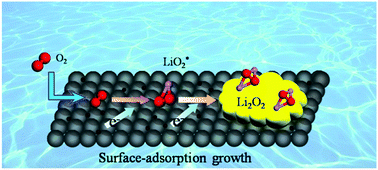Photoinduced decoration of NiO nanosheets/Ni foam with Pd nanoparticles towards a carbon-free and self-standing cathode for a lithium–oxygen battery with a low overpotential and long cycle life†
Abstract
Constructing an air electrode with a porous structure and tunable chemical composition can provide a solution to improve the performances of Li–O2 batteries. Herein, via a facile synthesis strategy by combining electrodeposition and photoreduction, we have fabricated a free-standing cathode with palladium (Pd)-modified NiO nanosheets (NS) grown on Ni foam (PNS). The Li–O2 battery with the PNS cathode delivers a high capacity (18 900 mA h g−1 at 200 mA g−1), a much reduced charge overpotential (∼0.35 V), and a long-term cycling life (103 cycles at 200 mA g−1 and 1000 mA h g−1). These properties are due to the good activity of NiO/Pd catalyst, the highly porous structure of NiO nanosheets, and the absence of an organic binder. More importantly, film-like Li2O2 is formed via a surface growth pathway in the PNS cathode, providing a large contact area between the Li2O2 and cathode surfaces. As a benefit, the electron transfer during the charge process is facilitated, contributing to a much reduced charge overpotential.

- This article is part of the themed collections: Horizons Community Board Collection – Advanced Energy Storage Technologies and International Year of the Periodic Table: Elements for Next Generation Batteries


 Please wait while we load your content...
Please wait while we load your content...